Jay DeFeo has been repeatedly characterised by critics, historians and fellow artists as ‘an independent visionary’, devoted to ‘“private” art’, who was ‘professionally reclusive’.1 As early as 1963 the critic John Coplans cast DeFeo, together with other American artists working on the West Coast, including her friend Wallace Berman, as ‘isolated visionaries’ cloistered ‘in complete retreat’.2 The tenacity of this myth stems partly from the work for which DeFeo has become most famous, and indeed infamous: she re-worked her gargantuan oil painting The Rose obsessively between 1958 and 1966, and the energy expended on it forced a four-year career break until 1970.3 The Rose, and by extension DeFeo, have been co-opted as ‘representative of Bay Area abstract painting in microcosm’, invoked as symptomatic of West Coast 1950s and 1960s artistic production, understood as a brief flare of creativity eclipsed by New York.4 DeFeo’s hiatus seems to bisect her output into two sections: the works made during the 1950s and early 1960s on the one side, and those from the 1970s and the 1980s on the other.5 Yet rather than being an isolated or disjointed practice, DeFeo’s work exhibits remarkable consistency and, moreover, an ability to combine multiple influences and ideas. While her paintings are predominantly abstract, DeFeo’s understanding of abstraction is heterogeneous and assimilative in terms of process and inference alike, incorporating paint, drawing, jewellery, assemblage sculpture, photography and collage, while holding landscape, biological and bodily references in play.
Focusing on the work that she developed during the 1950s and 1960s, this essay seeks to define DeFeo’s practice as one of hybrid abstraction, through which she created paintings that blend the organic and sensual, and which resulted in environmental situations that make a physical address to the viewer. Writing to the painter Fred Martin, DeFeo said of her paintings that she wanted ‘to “live in them”’ and stressed their relationship to ‘the environment that I live in’, vividly conveying the liminal, encompassing qualities she sought to achieve.6 In a 1980 review celebrating DeFeo’s increased visibility after her return to painting a decade earlier, the critic Thomas Albright evocatively described DeFeo’s earlier work as ‘immense creations that mixed house paint, stones, string and God knows what else, making great, lava-like slags that carried Abstract Expressionist textures into a dimension of funky, hybrid painting-sculpture’.7 The term ‘hybrid’ – which refers to an entity composed of multiple, diverse sources, and is often applied to plant and ecological forms – has particular application to DeFeo’s abstraction, which emerged through the intersection of abstract expressionism, landscape painting, assemblage sculpture, and the legacies of surrealism and transcendentalism that filtered through the Beat writers and poets.8
In contrast to the ‘rhetoric of purity’ identified by the art historian Mark Cheetham as a central aspiration of twentieth-century abstraction, and modernist formalism’s prioritisation of the flat picture plane and medium-specificity, DeFeo forged an accumulative working process that could keep a number of haptic and conceptual referents in tension.9 The effects are closer to East Coast formulations from the mid-1960s such as Lucy Lippard’s bodily and psychosexual conceptualisation of ‘eccentric abstraction’, and Donald Judd’s 1965 claim that the best recent works in New York were borderline productions that comprised ‘neither painting nor sculpture’.10 DeFeo’s canvases demonstrate the painterly as well as the geographic lacunae in Lippard’s writing on ‘eccentric abstraction’, with the critic herself observing that ‘the eccentric idiom is more closely related to abstract painting than to any sculptural forms’.11 Yet DeFeo’s painting remains invested in evocations of natural, organic and environmental process, unlike the sculpture championed by Lippard and Judd. Equally, although there are illuminating affinities between DeFeo’s work and the West Coast sculpture, ceramics and assemblage that the curator Peter Selz ill-fatedly attempted to define as ‘funk’ in 1967, as Albright’s allusion to the ‘funky’ qualities of her ‘painting-sculptures’ indicates, the sensuously phenomenological quality of her work is decidedly distinct from the machismo and pop-culture references of many of the artists Selz included under this label.12 DeFeo’s work offers a compelling alternative to these positions, while reconfiguring the legacies of abstract expressionism.
Focusing attention on the hybrid qualities of DeFeo’s abstraction enables her work to be re-situated within the socio-political context of Cold War America, and the negotiations between individual and collective endeavour, freedom and repression that characterised this period. Rather than isolation, the San Francisco community that DeFeo participated in during the 1950s and 1960s was shaped by exchange and engagement, through which multiple modes of artistic production co-existed and cross-fertilised each other. The first section of the essay roots DeFeo’s practice in this setting, demonstrating that her pursuit of hybrid abstraction was part of a wider shift away from abstract expressionism in the Bay Area, and connected to experiments in assemblage and poetry. The second section addresses how this hybridity fostered DeFeo’s pursuit of landscape forms and organic references. Building on this, the third part proposes that one of the landscape forms that most interested DeFeo was the subterranean space of the cave, which resonated with Cold War fears and anxieties. The conclusion advances this argument, considering how the sensual nature of DeFeo’s practice stands in direct opposition to cultural conformism, while demanding an embodied response from the viewer that had parallels with, but ultimately differs from, ‘eccentric abstraction’.
Exhibition as environment
Throughout the 1950s DeFeo played a key role in artistic circles that engaged with both the legacies of abstract expressionism and the evolution of new artistic practices. The heterogeneous nature of this milieu was central to DeFeo’s development of hybrid abstraction. Reflecting on a panel discussion held at the Oakland Municipal Art Museum in February 1956, in conjunction with an exhibition entitled ‘California School – Yes or No?’, Fred Martin asserted that the answer was a resounding negative.13 ‘Present on the panel’, he wrote, ‘were two of those that had killed it – [David] Park and [Richard] Diebenkorn – and in the audience were three others – Jay DeFeo, Wally Hedrick, and Sonia Gechtoff’.14 Martin perceived a clear distinction between the younger ‘abstract or non objective painters’ in northern California, and their teachers and predecessors who had coalesced around the California School of Fine Arts in San Francisco during the 1940s.15 Under the leadership of Douglas MacAgy between 1945 and 1950, the School of Fine Arts had become a hotbed of abstract expressionism, buoyed by an influx of mature students studying on the GI Bill, with classes led by painters including Clyfford Still, Hassel Smith and Elmer Bischoff, and a summer school taught by Mark Rothko in 1947. Yet while DeFeo, who studied across the bay at the University of California, Berkeley between 1946 and 1951, remembered feeling ‘the vibrations kind of coming over … from Clyfford Still and Rothko and all of those people that were just a generation ahead of me’, by the early 1950s the notion of a ‘California School’ was already dissipating, with several artists returning to figuration.16 As Martin later reflected in relation to the Oakland discussion, ‘the whole thing had split up into the two armed camps … And even before that it was splitting because Still couldn’t stand to have anyone else visible’.17 By the time DeFeo and her contemporaries graduated, abstract expressionism’s tenets were ripe for questioning.
The difference that Martin observed between an older ‘California School’ and the experiments of the mid-1950s is encapsulated by an exhibition organised by the curator Walter Hopps in 1955 entitled Action 1, which included DeFeo’s early painting Untitled from the Tree series, alongside works by Gechtoff, Smith, and Roy De Forest.18 Hopps felt ‘compelled’ to show a group of artists he identified as ‘the new California expressionists’.19 This echoes Martin’s conviction that these artists were producing innovative abstraction, albeit one with links to the critic Harold Rosenberg’s concept of ‘action painting’.20 The site that Hopps secured for Action 1 was the merry-go-round building at the end of the Santa Monica pier in Los Angeles. He hung the paintings at various levels in the space around the carousel, over which tarpaulins had been stretched, inviting an irreverent connection between the fun of the fair in all its tinsel glitter, and the dynamic movement of the brushwork. For the art historian Serge Guilbaut, the result was a ‘subversive environment’, which revelled in the ‘combative’ possibilities of abstract painting.21 A radical quality can also be found in the exhibition’s public-facing nature. Hopps described how ‘it attracted the most totally inclusive mix of people – Mom, Dad, and the kids, and Neal Cassady, and other strange characters, and the patrons of a transvestite bar nearby. I got [Allen] Ginsberg, [Jack] Kerouac, and those people to attend’.22 Action 1 presented abstraction as part of a milieu populated by Beat writers such as Ginsberg and Kerouac, in which abstract expressionism’s emphasis on the individual’s capacity to act found a new resonance with the collective disaffection and societal rejection of the counterculture. There was a democratic address to Hopps’s experiment, in which abstract painting was presented as part of a wider environment rather than confined to traditional gallery spaces.
The unusual environment of Action 1 exemplified the informal exhibition network that developed between the painters, assemblage sculptors and filmmakers DeFeo lived and worked among after moving to San Francisco in 1954.23 Together with group and solo shows at the Dilexi Gallery, which opened in San Francisco in 1958, DeFeo exhibited at the Ferus Gallery in Los Angeles.24 Also in San Francisco, DeFeo provided a ‘helping hand’ at the Six Gallery, a cooperative that her then-partner Hedrick had founded with five other artists, reporting that ‘reviews are regular & good – or that is, they seem to bring many people in, which is what interests us’.25 Between 1955 and 1958, Gechtoff’s mother Ethel ran the East and West Gallery, and ‘gave Bruce Conner and Roy De Forest their first shows … She hardly sold anything, but she got a hell of a lot of attention’.26 While Action 1 was perhaps the most experimental exhibition with which DeFeo was involved, the Dilexi, Six and East and West Gallery provided space for a range of works – from Conner’s assemblages to De Forest and Smith’s abstract paintings – in which exhibitions could assume environmental, sometimes interactive, qualities.27
It was at the Six in 1955 that Ginsberg gave a reading of his new poem Howl, which as the writer Rebecca Solnit has noted occurred within a sculptural installation by Martin, described by the poet Michael McClure as sections of ‘orange crates that had been swathed in muslin and dipped in plaster of Paris to make splintered, sweeping shapes like pieces of “surrealist furniture”’.28 This overlap between painting, sculpture, music and poetry was reflected in the frequent use of bars as exhibition venues. The artist Joan Brown, also part of DeFeo’s circle, recalled how she and her friends would cart ‘great big stupid sloppy paintings’ through the streets to the Old Cellar bar, where they would be shown while jazz musicians played.29 The avant-garde filmmaker Harry Smith made abstract psychedelic murals for Jimbo’s Bop City in San Francisco during 1950, ‘probably in payment for his overextended bar tab’.30 The first space housed by the Dilexi was above a jazz bar in North Beach, its director James Newman aspiring to create ‘a sort of gallery kind of lounge’.31 Throughout the late 1950s and early 1960s Wallace Berman, who moved to San Francisco from Los Angeles in 1957 before returning to southern California in 1961, distributed the nine volumes of his Semina publication among his close friends, which acted as a space and conduit for the display and circulation of surrealist and imagist writing.32 Berman’s ‘lifelong fascination with Surrealism, especially with Jean Cocteau and Antonin Artaud’ manifested itself in the pages of Semina, and was shared by many of its contemporary Beat contributors.33 DeFeo’s careful preservation of several poems from the individual loose leaves that made up each edition of Semina indicates the publication’s importance for her work.34
In this dynamic context, abstract and figurative painting co-existed alongside assemblage, film, poetry and performance.35 This exhibition scene grew out of the working environment of many Bay Area artists. After shifting between a series of apartments, DeFeo and Hedrick settled at 2322 Fillmore Street in 1955, a block that housed several artists during the 1950s including Brown, Gechtoff and her husband James Kelly, McClure and the sculptor Manuel Neri. DeFeo described how in ‘this fabulous bunch of tenements’ an internal door linked the two parallel lower flats, ‘connecting Sonia’s, later Joan’s and my studios’.36 Brown observed that this proximity fostered ‘a high peak in terms of energy … And we charged each other up, constantly … I say we because that’s how it was. It was a “we”’.37 While this communality did not always foster explicit collaboration, Brown felt it encouraged openness to materials like house paint, plaster and found objects:
We were all electric and … in a terrible hurry … So naturally working with these materials you can work very fast, you can work spontaneously, you can change them instantaneously, almost … With painting you just didn’t bother to mix anything. You’d just take this out with the trowel, slap it on, you could wipe it off the next second or push it somewhere else.38
Brown and DeFeo produced very different paintings – figurative and abstract respectively – but they shared an ‘attitude’.39 In 1967 the curator Peter Selz, who had moved to the West Coast from New York, attempted to define this impulsive and instinctual attitude with his exhibition Funk at the University of California, Berkeley. He identified ‘funk’ as an ‘idiosyncratic, sensuous, irrational, amoral, organic, visceral’ outlook permeating Californian art.40 Selz controversially omitted many Bay Area artists from his show such as Hedrick who had been active in the 1950s and early 1960s, sparking a backlash against his characterisation of the concept.41 Together with other commentators at the time, such as the artist Harold Paris, Selz sought to distinguish ‘funk’ from earlier assemblage sculpture, instead turning to ceramists like Robert Arneson and Peter Voulkos.42 Yet Selz suggestively rooted his ideas in the abstract painterly practice that had emerged on the West Coast during the 1950s, describing how ‘in San Francisco Abstract Expressionism, originally under the leadership of Clyfford Still and Mark Rothko, soon took an eccentric direction’.43 Although Selz cited the ‘witty, zany, and unexpected breast forms and bulges’ in Hassel Smith’s canvases, and the ‘dramatic and disquietingly sensual, often phallic configurations in Frank Lobdell’s heavy impastos’, his account of the ‘eccentric direction’ taken by abstraction in the Bay Area resonates with DeFeo’s work, while pointing to its emergence from a lively, interactive and fluid environment of determinedly independent, but mutually conducive artistic activity.44
From merry-go-rounds to mountains
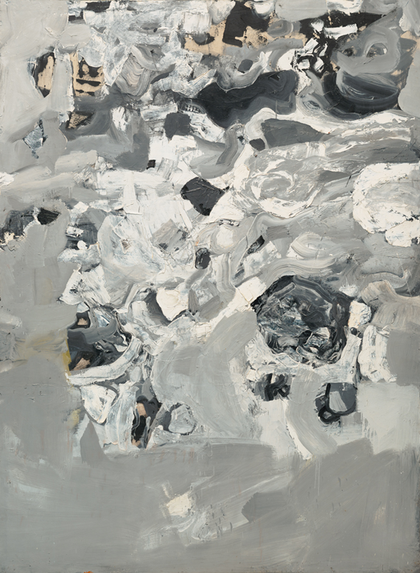
Fig.1
Jay DeFeo
Untitled (Everest) 1955
Oakland Museum of California; Gift of Jay DeFeo
© The Jay DeFeo Trust
For all the limitations of his definition, several of the adjectives Selz used to characterise ‘funk’ are particularly pertinent to DeFeo’s work, especially ‘sensuous’, ‘organic’ and ‘visceral’. DeFeo’s incorporation into her abstract painting of organic, but particularly biological and geological references in a way that goes beyond Selz’s terms, can be detected in the first large-scale series that the artist embarked on after moving to Fillmore Street, which provided DeFeo with freedom to expand ‘on a grand scale’. Up until this point, she had been ‘crammed into a corner of our kitchen’ in a house she and Hedrick rented on Bay Street.45 DeFeo began what became her Mountain Series, culminating in her large-scale painting Incision, which she worked on for two years between 1958 and 1960. As Martin expressively phrased it, during this period DeFeo produced ‘an avalanche, a safe place in the ice, an adventure on a glacier and a chain of very high mountains’.46 DeFeo later recalled ‘we were all interested in mountain climbing and things of that nature’, underlining the place that mountains held in the collective imaginary of her peers during the 1950s.47 The subtitle of Untitled (Everest) 1955 signals the painting’s landscape affiliations, while at two and a half metres tall hints at the literal heights DeFeo would scale in Incision.
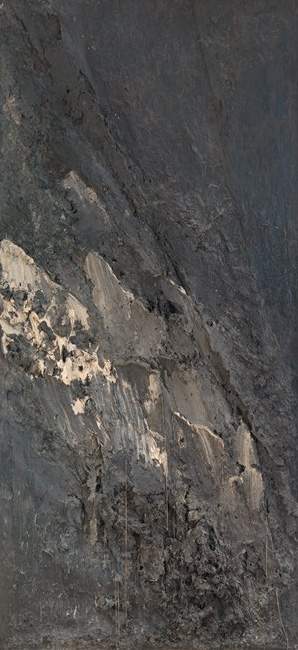
Fig.2
Jay DeFeo
Incision 1958–60
San Francisco Museum of Modern Art
© The Jay DeFeo Trust
DeFeo animated the surface of Untitled (Everest) by layering her paint in thick brushstrokes (fig.1). These coagulate like conglomerate rock, or stratified sediment glinting with flinty segments of coal-black stone. Small sections of the canvas and of older undercoat, glimpsed through gaps in the overlying turbulent froth of paint, reinforce this latter sensation, forming a texture that Solnit compared to ‘relief maps or wall sculptures’.48 The paint application is fluid and heavy, at points congealing in unassimilated globules left in the wake of a pallet knife or large brush. Elsewhere, white highlights merge with greys to create atmospheric allusions redolent of water vapour and fast-moving weather. While Untitled (Everest) seems occasionally about to cohere into identifiable imagery, it remains in flux. DeFeo’s placement of ‘Everest’ in titular brackets infers the generalised idea of a mountain, rather than topographical actuality. As DeFeo emphasised, her engagement with the natural environment did not result in ‘landscapes that one goes out and parks oneself down in the field to paint … they are landscape-like. They conjure up a kind of landscape feeling’.49 Untitled (Everest) might offer a view down from a summit onto the terrain below, or even a glimpse of peaks breaking through cloud from the air, yet the composition also pitches the viewer into a granular, micro-level view of a rocky surface, frustrating a clear perspective.
Incision, which looms over the viewer from just shy of three metres, takes the immersive quality of Untitled (Everest) to extremes (fig.2). Albright described it as a ‘massive encrustation’ of a painting, with ‘bleak sludges of marbled black, white and gray that seem to struggle against their own mass and weight’.50 In places the accrued mixture of oil paint and house paint – which DeFeo used for its cheapness – juts out from the canvas, mounted on board for structural support, to nearly twenty centimetres in depth. Limp strings fall from where DeFeo secreted them inside the compacted paint, like frail stalactites. As Martin observed, DeFeo’s work, while abstract, is also ‘a concrete art’.51 This is manifested in the physical rent that DeFeo gouged into the built-up paint, cutting diagonally from top left to bottom right like a mountain crevasse. Running parallel with this crack in Incision’s surface, DeFeo applied a spatter of white, which combines with the overall downward dynamic of the composition to suggest a burst of spray from a raging cataract or waterfall. Towards the bottom, the paint is so thick and knotted that it assumes the quality of weathered rock, reaching out into the viewer’s space like an environment that could indeed be ‘lived in’. As DeFeo reflected, ‘I seem to demand an image within a field, with a semi-landscape feel to it. I also like to work … very large, so as to give one a sense of walking into or becoming part of the image’.52 The geologic connotations of DeFeo’s canvases threaten as much as welcome. Intriguingly, although undeveloped in his essay, Selz borrows a dictionary definition of ‘funk’ from Webster’s dictionary as an epigraph, which gives the meaning: ‘to be frightened and shrink back; to flinch, as to funk at the edge of a precipice’.53 DeFeo noted the sense of ‘what is not welcoming’ infusing her canvases, whereby attraction and repulsion mingle.54

Fig.3
Jay DeFeo
Origin 1956
Berkeley Art Museum and Pacific Film Archive; Gift of Mr and Mrs John S. Hilson
© The Jay DeFeo Trust
Mountain ranges, steep gorges and strata are all topographies that have affinities with the kinds of terrains typically used to evoke sublime experience. DeFeo framed her work for the 1959 Sixteen Americans exhibition at the Museum of Modern Art in New York in these terms: ‘only by chancing the ridiculous, can I reach the sublime’.55 Yet DeFeo’s take on the sublime can be best interpreted as a means of bringing about hybrid states, whereby the boundaries of individual selfhood dissolve and the subject merges with the wider environment, rather than expressing fear at overwhelming phenomena distinct from the individual.56 In this respect it owes much to longer histories of American transcendentalist thought and its celebration of natural phenomena. The critic Alfred Frankenstein intuited the links between DeFeo’s work and that of nineteenth-century writers such as Ralph Waldo Emerson, Henry David Thoreau and Walt Whitman. Singling out DeFeo’s 1956 canvas Origin from a 1959 group show at the Dilexi, Frankenstein concluded that ‘Walt Whitman would have been the first to approve what Miss DeFeo says here’.57 The forceful composition of Origin consists of marbled grey striations running from top to bottom of the canvas (fig.3). DeFeo began each of the ‘powerful, vertical strokes’ with a thick lick of wet paint. These viscous genesis points are left unworked, overlapping like a fan of fish scales or feathers that almost seems to lift off the surface.58 The viewer’s eye can follow and re-enact the movement by which DeFeo drew each mark down the canvas to create a cataract of intermingled greys, browns and whites which merge with a grainy, ridged texture. Just as Whitman opened his poem Leaves of Grass (1891–2) by celebrating the individual’s place in the multitude – ‘One’s-Self I sing, a simple separate person / Yet utter the word Democratic, the word En-Masse’ – so too might Origin enact the delirious slippage between differentiation and unification.59
In Song of Myself, the most well-known section of Leaves of Grass, Whitman conceives of a subject who ‘contains multitudes’, and merges with the surrounding environment: ‘I find I incorporate gneiss, coal, long-threaded moss, fruits, grains, esculent roots / And am stucco’d with quadrupeds and birds all over.’60 Leaves of Grass unfolds a vision of organic integration between the human and natural worlds, which finds correlations in DeFeo’s hybrid abstraction. Curator Dana Miller has traced the longstanding influence of William Blake’s poetry on DeFeo, and like Blake, Whitman understood the macro and microcosmic as fundamentally interconnected, judging ‘a leaf of grass no less than the journey-work of the stars’.61 Romanticism and transcendentalism infused the Beat milieu of 1950s San Francisco, while as curator Lisa Philips has noted, ‘the Beats … inherited a long tradition of dissent in America that runs from Emerson and Thoreau and Whitman to the pioneer-outlaw’.62 Although there are correspondences between DeFeo’s work and Whitman’s poetry, perhaps a closer transcendentalist parallel for works like Origin and Incision can be found in Henry David Thoreau’s 1854 book Walden, an account that the writer compiled after a year spent living as self-sufficiently as possible by a lake in Massachusetts. In one section, Thoreau records his wonder at the intricate, lace-like forms made by thawing sand and clay as it bursts through snow and ice covering the sides of a railroad cutting. ‘As it flows’, writes Thoreau, ‘it takes the forms of sappy leaves or vines, making heaps of pulpy sprays a foot or more in depth and resembling, as you look down on them, the lacinated lobed and imbricated thalluses of some lichens; or you are reminded of coral, or leopards’ paws or birds’ feet, of brains or lungs or bowels, and excrements of all kinds.’63 This ‘hybrid product’, as Thoreau called it, reveals a terrain that looks ‘as if the globe were turned wrong side outward’.64
In Incision, DeFeo’s combination of thick paint and string similarly assumes the quality of a ‘hybrid product’. Its abstract forms and textures combine references to geology, minerals, coral and rock formations, while alluding viscerally to the body and Thoreau’s ‘brains or lungs or bowels, and excrements of all kinds’. This again chimes with Selz’s identification of funk with ‘erotic and scatological forms or relationships’.65 Incision thus bears out DeFeo’s later statement that she was never ‘the kind of classic, stereotyped abstract expressionist that people always imagine me to be … I am somewhat outside the mainstream. I was even outside the mainstream during the time when abstract expressionism was a trend’.66 Instead, the abstraction of Incision, with its associative and physical hybridity, is invested in a different set of concerns about the body and its environment, and with their intimate relation.
Caves and cathedrals
Together with mountains, the interior spaces of caves and cathedrals were equally important for DeFeo’s environmental, hybrid abstraction. On completing her studies at Berkeley, DeFeo was awarded a travel grant to Europe, and between 1951 and 1953 visited France, Britain and Italy. During this trip DeFeo indulged her passion for European architecture, specifically ‘the floor plans of the cathedrals’, bequeathed by art history classes.67 She was also interested in a very different, but similarly vast architectural space, that of the ancient cave-complexes in France and Spain, especially Lascaux and Altamira. DeFeo recalled: ‘what I wanted to do in Europe, which I did, was to crawl through all the caves and look at all the cave paintings and scrawls.’68 In her enthusiasm for cathedrals and caves, DeFeo took a phenomenological approach that emphasises the bodily experience of being in each site, intimating the need for visitors to orient themselves physically in relation to a floor plan, or ‘crawl’ through a confined space, in order to understand it fully.69
DeFeo’s visits to Lascaux and Altamira, together with research at the Museé de l’Homme in Paris and the British Museum in London into ‘prehistoric sites in England and Ireland’, inform the works she made during a burst of creativity towards the end of her European travels.70 Lascaux, discovered in 1940 and opened to the public in 1948, attracted popular and artistic attention because of its detailed wall paintings.71 In Untitled (Florence) 1952, DeFeo mixed tempura and synthetic polymer on paper, experimenting with a medium used traditionally for frescoes: the top half contains a stylised bird-creature executed in yellow and orange. Its waxy outline cuts through the sections of lighter red paint as if etched into rock. DeFeo transplanted and condensed the prehistoric wall-drawings that intrigued her into an abstracted symbol, floating within washes of intense colour. Untitled (Florence) is an early example of the archaeological impulse informing DeFeo’s work, which saw her create a stratified painterly abstraction out of physical and symbolic layering.
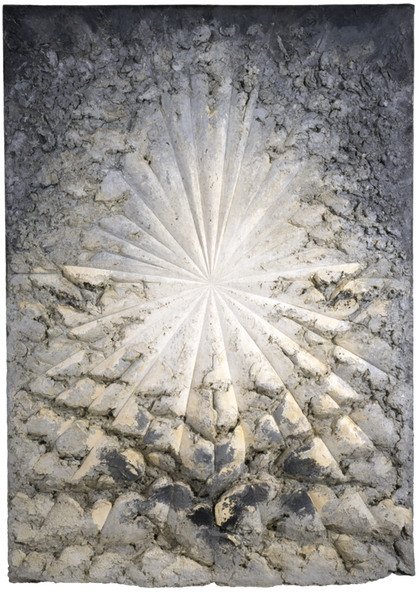
Fig.4
Jay DeFeo
The Rose 1958–66
Whitney Museum of American Art, New York; Gift of the Jay DeFeo Trust
© The Jay DeFeo Trust
Although after her return to California in 1953 DeFeo moved towards increasingly ambiguous, abstracted imagery, the cave connotations of Untitled (Florence) re-emerged in Incision, which infers a grotto-like fissure as well as a mountainous terrain; or, in the words of Thoreau, ‘a cave with its stalactites laid open to the light’.72 Work on Incision overlapped with starting The Rose, sections of which comparably rise outwards from the canvas to nearly thirty centimetres (fig.4). Making The Rose was an all-consuming experience, which demanded ‘physical endurance’ and ‘the energy necessary to move mountains’.73 DeFeo identified the resulting work as ‘a sculptural painting in three dimensions, literally a relief’, indicating that she conceived of it as a haptic, enveloping structure as much as a painting.74 If the three-dimensionality of Incision invites viewers to enter its field, The Rose similarly combines the impression of ephemeral streams of light with that of a tangible, rocky surface. DeFeo heightened this impression by adding mica to the paint that she trowelled onto the canvas, bestowing it with a mineral glitter.75 In the final version of The Rose, the lines emanating from its centre are etched into the surface with lapidary precision, dissipating into pitted clumps of craggy grey-black paint towards the top of the canvas. For the artist Margaret Peterson, who taught DeFeo at Berkeley, the resulting connotations of cave-architecture and carving were evocative of the ‘stone age’.76

Fig.5
Jerry Burchard
Jay DeFeo standing in front of The Rose at 2322 Fillmore Street, 1959
© The Jay DeFeo Trust
While DeFeo’s abstracted manipulation of paint in The Rose, like Incision before it, had strongly geological overtones, the space in which DeFeo worked on the painting between 1958 and 1966 also assumed the status of a grotto or shrine, a hybrid of the caves and cathedrals that had so fascinated the artist in Europe. A photograph taken in 1959 by Jerry Burchard shows The Rose dwarfing the central section of a bay window, almost touching the ceiling (fig.5). Light streams across The Rose’s carved surface from the two side wings of the bay, throwing it into dramatic relief. This effect was important for DeFeo. When The Rose was later relegated to a boardroom in the San Francisco Art Institute, she observed that ‘the painting isn’t very photogenic in its present storage place … It needs the side-lighting it had in the original studio setting’.77 Burchard’s image captures DeFeo silhouetted against this luminescence, the details of her face and body blotted out. Her figure is at once overwhelmed by the painting, but also incorporated into its field, part of the environment established by its large size and drastically reduced but striking motif. Burchard’s theatrical photograph underscores the affinities between The Rose’s setting and altarpieces, places of pilgrimage and subterranean spaces illuminated by flickering light, and with liminal zones marking transformations rather than end-points. It encapsulates how DeFeo’s work tests the boundaries between antinomies such as light and dark, interior and exterior, tangible and intangible, embodiment and disembodiment, and by extension self and object, constantly moving between the reiteration and breakdown of these dichotomies and definitions.
Bruce Conner, a close friend of DeFeo’s who later agitated for The Rose’s conservation, noted this contiguous relationship between painting and site. He recalled that the Fillmore Street studio ‘had no electricity; when the sun came up, the room was illuminated, she worked on the painting … The light went away, she left the room. The room was like a temple’. 78 Comparably, Hopps described how, ‘paint encrusted the floor and the walls around, giving the impression of a primordial cave’.79 As captured by Conner’s 1967 film The White Rose,80 the painting became so embedded in the Fillmore Street residence that when DeFeo and Hedrick were evicted a section of the wall had to be removed before The Rose could be prised from its setting, like a recalcitrant gemstone from a ring. For Greil Marcus, Conner’s camera adopted the perspective of an ‘archaeological crew’ discovering an ‘ancient ruin’, documenting ‘dead plants, rotting fixtures, encrusted paint cans that look like the 15,000-year-old oil lamp found in the cave of Lascaux’.81 DeFeo thanked Conner for his film, because ‘it says a lot The Rose can’t say for itself’, indicating that this mise-en-scène was vital to her conceptualisation of the painting.82
This setting might seem to uphold characterisations of DeFeo as an isolated ‘visionary’. Yet the environment of The Rose participated in shared contemporary cultural narratives that spoke of the desire for retreat and protection in the face of Cold War nuclear threat. Art historian Jane Pavitt has observed how the artistic and architectural obsession with cave-space in Europe and the US during the 1940s, triggered partly by the discovery of Lascaux, ‘came at a time when the ultimate destruction of humanity seemed imminent’.83 Pavitt argues that this interest in caves continued to inform Cold War architecture, with its enthusiasm for protective structures, intended to shelter inhabitants from nuclear bombs and fallout. As architectural historian Beatriz Colomina has noted, ‘cave dwelling, like bomb shelters, submarines, and spaceships, corresponds to a time of extreme danger outside. Caves are all interiorized spaces, the first bunkers’.84 The archaeological ramifications of DeFeo’s layered abstraction in The Rose, and the way contemporaries such as Conner, Hopps and Burchard understood painting and environment as interrelated, indicates the engaged rather than isolationist stakes of her practice.
While it is the cave-metaphor that perhaps most powerfully links DeFeo’s work to Cold War anxieties, her interest in luminescence and the explosion of light and matter outwards from a central point also see her work testing contemporary fears. Earlier canvases such as Song of Innocence 1957, The Annunciation 1957–9 and The Jewel 1959 also employed the motif of forcefully exploding or imploding light. In Song of Innocence, softly tessellating grey, white, brown and black brush marks emerge from the canvas’ centre in a gritty, dusty, shimmering cloud, which has menacing undertones for all its beauty. DeFeo celebrated the ‘sense of ominousness’ that she achieved through such modulations of light and dark, tangibility and transience, form and formlessness.85 Albright directly connected these roiling bursts of dirty, silvery light in paintings like Song of Innocence, as well as the tectonic collisions of Incision, with ‘the image of a mushroom cloud … in a shadowy corner of the psyche’.86 The ominous quality that DeFeo sought to achieve in her paintings is closely linked to their sense of dissolution and blurred boundaries, and this use of hybrid abstraction to stage states of disintegration registers the fears of the Cold War period.
As Phillips has noted, ‘born in the Depression, the Beats spent their adolescence in wars, both hot and cold, and matured in the shadow of nuclear holocaust. Amid the smug optimism of the Eisenhower years there was plenty of anxiety and discontent’.87 Selz has argued that these fears were heightened on the West Coast, which witnessed a ‘tremendous boom in California’s defence industry’ after the Second World War. This entailed that ‘the narrowing of politically and socially acceptable behaviour was particularly restrictive in California, where the military’s presence was the strongest’.88 In the early to-mid 1950s the conservatism embodied by Senator Joseph McCarthy’s anti-communist witch-hunts directly affected artists in DeFeo’s circle, with exhibitions and artworks subjected to censorship.89
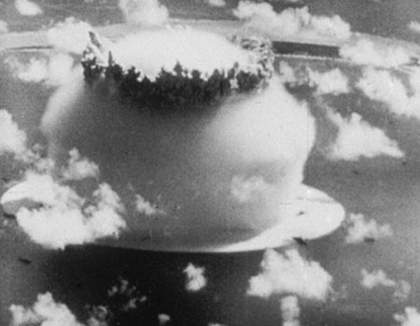
Fig.6
Bruce Conner
Still from A Movie 1958
© The Conner Family Trust
Flickers of fear and anger about militarisation ran through DeFeo’s artistic network. Several of Hedrick’s paintings drew on his experiences as a soldier in the Korean War and overtly critiqued US intervention in Vietnam. Conner’s 1958 film A Movie, created by splicing together sections of found black-and-white footage, combines shots of atomic mushroom clouds bursting heavenwards with submarines releasing under-water missiles (fig.6). By merging these images with soft-pornographic clips of a model gazing invitingly into the camera, A Movie succinctly links military aggressions with erotic drives. Conner was so exercised by the nuclear threat that between 1961–2, as the Cuban Missile Crisis developed, he travelled to Mexico: ‘I was sure the bomb was going to drop and we’d be annihilated. So I’d go to Mexico and figure out how to live in the mountains after the bomb dropped.’90 The similarities between the explosions that blossom across DeFeo’s canvases, and the images of nuclear detonation in A Movie, together with the enveloping qualities of her paintings, can be understood as thought experiments in obliteration.91 Looking back on the 1950s and early 1960s in the Bay Area, Brown recalled a ‘kind of destructiveness … “Eat, drink and be merry for tomorrow we die” is the attitude which was very prevalent at that time’, but also, paradoxically, ‘delight’.92 DeFeo modulated physical and mental boundaries through abstraction to imagine the dissolution of selfhood as both terrifying and fascinating.
Dissolution and transformation
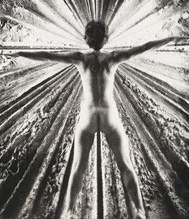
Fig.7
Wallace Berman
Jay DeFeo 1959
Whitney Museum of American Art, New York; Gift of the Lannan Foundation
© The Estate of Wallace Berman and The Jay DeFeo Trust
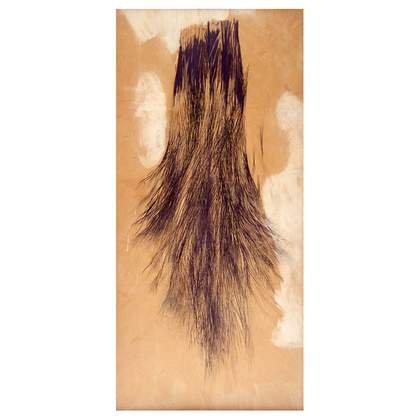
Fig.8
Jay DeFeo
Persephone 1957
Museum of Contemporary Art, Los Angeles
© The Jay DeFeo Trust
Conner’s film of The Rose was not the only response by DeFeo’s contemporaries to the work. Berman made a series of photographs of DeFeo standing naked in front of The Rose, arms outstretched, in an attempt to convey the ‘universal trip’ it represented to him (fig.7).93 Even more explicitly than Burchard’s photograph, Berman presents The Rose as occasioning a breakdown of bodily limits, the lines of DeFeo’s arms and legs merging with the painting’s contours. DeFeo’s consistent pursuit of dissolution and transformation informs the work that she executed in other media. While DeFeo worked on paintings like Origin, Untitled (Everest), Incision and The Jewel, she also created large-scale mixed media drawings such as Persephone 1957, for which she built up graphite, chalk and charcoal in layers that evoke whorls of hair, fur and fibrous plants (fig.8). Persephone is composed from dynamic strokes of graphite that flow in a central skein down the paper before fanning out at the bottom, like hair spilling over a back, or the tentacles of an anemone unfurling in the sea. The titular reference to the Greek myth, in which Hades abducts Persephone and takes her to the underworld, combine with the overriding connotations of hair and fur to create a distinctly bodily, unsettlingly sensuous impression.94
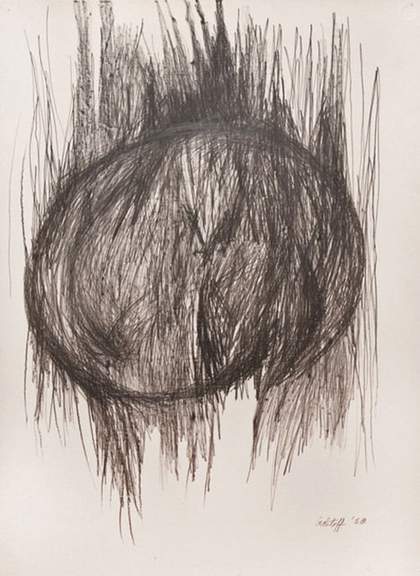
Fig.9
Sonia Gechtoff
Untitled Drawing No.4 1958
Pencil on paper
© Sonia Gechtoff
Detached from any referent that would help identify the source of these sinuous strands, Persephone assumes an uncanny, surreal quality, shared by drawings and paintings that Gechtoff produced at this time in which frenetic thick lines coalesce around a central point (fig.9). The abstract works that DeFeo and Gechtoff created, together with Brown’s use of fur in sculptures like Fur Rat 1962, testify to a shared interest in flowing, organic forms and materials that had subversively sensuous qualities, particularly given the conservative climate of Cold War America.95 The frank eroticism infusing Berman’s photographs of DeFeo in front of The Rose thus reverberates with the anti-conformist sensuality of the artist’s own drawings and paintings. This fluid sensuousness infuses paintings like Incision, whose trailing strings are reminiscent of Persephone’s swirling tendrils, and others such as The Jewel, where thick layers of paint break open under their own weight like fleshy ‘open wounds’, not to mention the collages that DeFeo produced throughout her career with their melded body parts such as Blossom 1958.96
Of all the models for abstract practice circulating in the US during the early to mid-1960s, DeFeo’s work arguably comes closest to Lippard’s ‘eccentric abstraction’, with its simultaneous qualities of ‘appeal’ and ‘repulsion’.97 In particular, drawings such as Persephone and paintings like The Jewel and Incision align with Lippard’s assertion that ‘abstraction is a far more potent vehicle of the unfamiliar than figuration, and erotic sensation thrives on the unfamiliar’.98 Lippard did connect the surrealist, Freudian qualities of ‘eccentric abstraction’ with so-called ‘funk art’ in San Francisco, which she associated with a ‘raunchy, cynical eroticism that parallels that of the New York artists’.99 Yet as Selz would a year later, Lippard concentrated on the slightly later work of Kenneth Price and Bruce Nauman rather than DeFeo. Subsequently, Lippard has proposed that DeFeo’s oeuvre ‘can, with hindsight, be contextualized within the feminist movement’.100 Lippard pointed to the shared ‘preference for organic or biomorphic forms rendered in repetitive, obsessive manner’ between DeFeo’s work and that of women artists working on the East Coast like Lee Bontecou, Lee Lozano and Eva Hesse.101 Yet rather than re-inserting DeFeo into Lippard’s 1966 formulation of ‘eccentric abstraction’, or arguing for a re-synchronisation of DeFeo’s practice with later definitions, we might understand her specifically painterly achievement as ultimately marking out a different trajectory.
Despite its affinities with ‘eccentric abstraction’, the references in DeFeo’s work to organic processes and landscapes, particularly mountains, caves and plant-life, set it apart from the key ideas staked out by Lippard. While Lippard and Selz both defined ‘eccentric abstraction’ and ‘funk’ respectively in relation to pop art, DeFeo’s work feels very far away indeed from the world of consumer and commodity culture. Instead, DeFeo’s painterly process comes closer to the kind of ‘hybrid product’ described by Thoreau, and his liquid invocation of ‘lichens’, ‘coral’, ‘leopard’s paws or birds’ feet’, and ‘brains or lungs or bowels’ forming interlaced patterns that convey the connectivity of all things. The transformation envisaged by her hybrid abstraction is intrinsically organic, based on biological interdependence. The environmental resonances of DeFeo’s abstract painting align her with a different range of socio-cultural concerns than artists like Nauman and Hesse. They see her engaging instead with the legacies of abstract expressionism and its emphasis on individualism, which provided antidotes to Cold War conformity and militarisation, but also surpassing them to pursue ideas about physical interrelation and psychological transcendence. The hybrid nature of DeFeo’s abstraction stages a constant tension between the desire to lose the self and the fear attendant on relinquishing control, so that the states of interdependence and sublimation envisaged in her work are constantly shot through with anxiety and excitement in equal measure.
